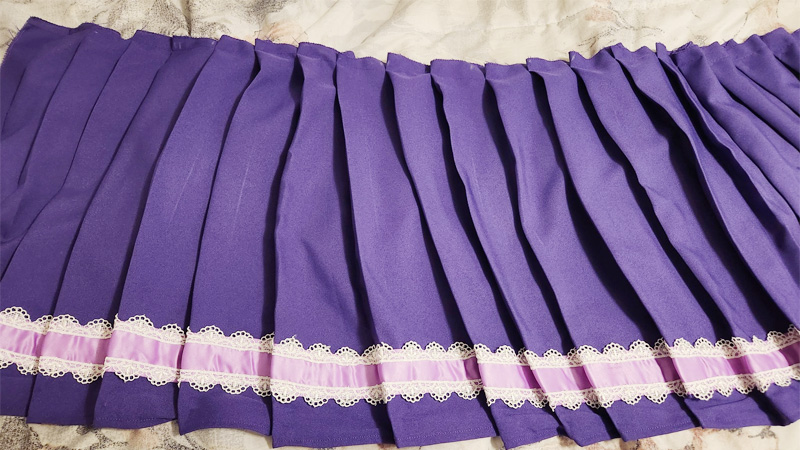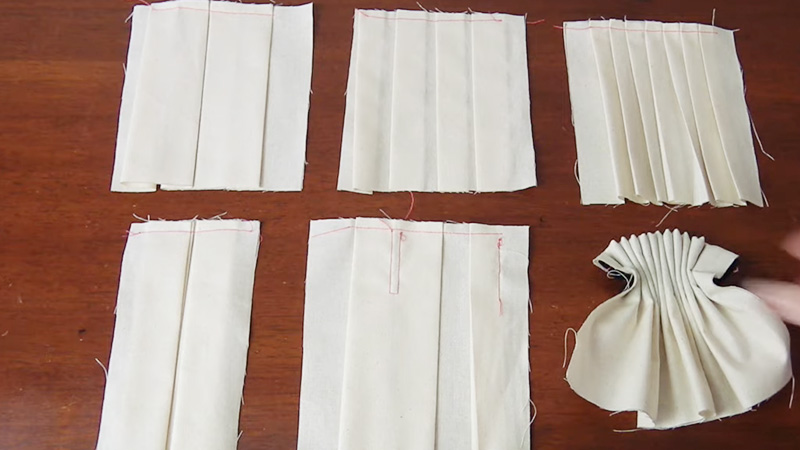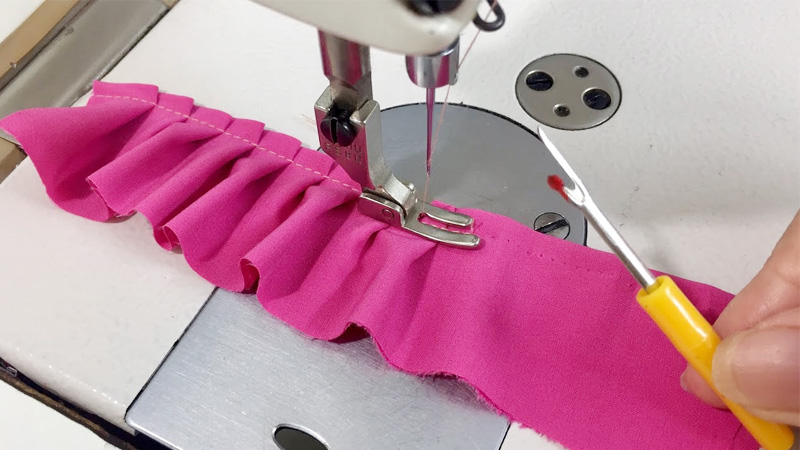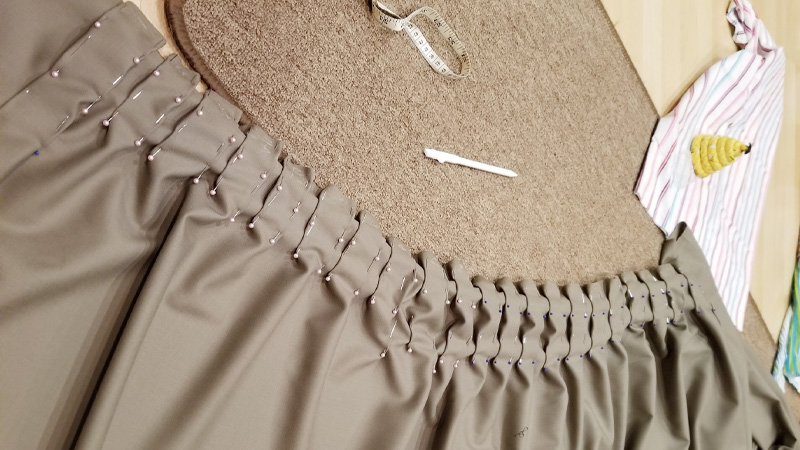Sewing pleats is like sculpting fabric into graceful folds, adding dimension, style, and structure to your creations. Whether you’re a novice or an experienced seamstress, mastering the art of sewing pleats opens up a world of creative possibilities in fashion and design.
Pleats can transform a plain piece of fabric into an elegant skirt, tailored trousers, or eye-catching home decor.
In this introduction, we embark on a journey into the fascinating realm of sewing pleats. We’ll explore how to sew pleats and methods that turn ordinary fabric into a canvas for expression and craftsmanship.
From basic single pleats to more intricate designs like box pleats and sunburst pleats, we’ll uncover the versatility and elegance that pleats can bring to your sewing projects.
So, let’s delve into the intricacies of sewing pleats, where precision meets creativity, to elevate your sewing skills to new heights.

How To Sew Pleats?
Creating pleats in sewing adds texture, style, and structure to garments and fabric projects. Here are the simple methods for sewing pleats:
Basic Single Pleat
Fold the fabric in one direction, creating a single pleat. Pin it in place, ensuring that the fold is even and aligns with your project’s design. Stitch along the top edge of the pleat to secure it. This classic technique is ideal for garments and tailored items.
Box Pleat
Fold the fabric in one direction, creating a pleat with two equal folds facing each other. The fabric resembles a “box” shape when viewed from the side. Secure the pleat with pins and stitch across the top to hold it in place.
Box pleats are commonly used in skirts and dress panels.
Knife Pleat
Fold the fabric in one direction, with each pleat facing the same way. Knife pleats create a flat appearance, ideal for uniforms or pleated pants. Pin and stitch along the top edge to secure the pleats.
Accordion Pleat
Create a series of pleats that fold back and forth like an accordion. Fold the fabric one way, then reverse the direction for the next pleat. Pin and stitch across the top to maintain the pleat’s structure.
Accordion pleats are popular for home decor and curtains.
Inverted Pleat
Similar to box pleats, the folds are inverted to face each other. This technique creates a tailored look and is often used in the back of skirts or as decorative features.
Sunburst Pleat
Form multiple small pleats radiating from a central point, creating a sunburst effect. Pin each pleat in place and stitch them down at the center. Sunburst pleats add dimension to decorative elements like pillows and tablecloths.
Chevron Pleat
Create V-shaped pleats by folding the fabric diagonally. Pin and stitch across the top to secure the chevron pleats. These pleats add a dynamic flair to clothing and accessories.
Each pleat style offers unique aesthetics and functionality, allowing you to customize your sewing projects with precision and creativity.
Types Of Pleats

Pleats are a classic and versatile element in sewing and fashion design. They not only add visual interest but also provide functional benefits in terms of fit and movement.
Here are the common types of pleats:
Accordion Pleats
Accordion pleats are characterized by their continuous, folded appearance, with pleats facing in alternating directions, resembling the bellows of an accordion.
These pleats are often used in skirts, dresses, and curtains, offering a sleek and elegant look.
Box Pleats
Box pleats consist of two equal-sized pleats that face each other, creating a flat, structured appearance. They are frequently found in garment design, particularly in the back of skirts and as decorative features on clothing.
Knife Pleats
Knife pleats are uniform pleats that face in the same direction, resulting in a smooth, flat finish. They are commonly used in school uniforms, kilts, and pleated pants, providing a neat and tailored appearance.
Inverted Pleats
Inverted pleats, also known as kick pleats, have their folds facing each other. These pleats are often found in skirts and dresses, creating a stylish and slightly flared look while allowing ease of movement.
Sunburst Pleats
Sunburst pleats radiate outward from a central point, creating a dynamic and decorative effect. They are popular in home decor, especially on items like tablecloths and curtains, adding a touch of sophistication.
Chevron Pleats
Chevron pleats form a V-shaped pattern by folding the fabric diagonally. These pleats are versatile and can be used to create unique visual effects in both clothing and accessories.
Crystal Pleats
Crystal pleats, also known as permanent pleats, are set using heat and pressure, creating pleats that are resistant to washing and ironing. These pleats retain their crisp appearance over time and are often seen in school uniforms and formalwear.
Each type of pleat offers a distinct style and functionality, making them valuable design elements in sewing and fashion.
The choice of pleat depends on the desired look and purpose of the project, whether it’s for creating structure, adding visual interest, or enhancing the overall design.
Supplies To Sew Pleats

To sew pleats effectively, you’ll need a set of essential supplies to ensure precision and a polished finish. Here are the supplies necessary for sewing pleats:
Fabric
Select the appropriate fabric for your project, considering the weight, drape, and texture. Light to medium-weight fabrics like cotton, linen, and wool are commonly used for pleated designs.
Ensure the fabric’s weave allows for easy folding and holding pleats in place.
Pins
Straight pins are essential for securing pleats in position before stitching. Use fine, sharp pins to prevent fabric damage, and pin along the pleat lines to maintain accuracy and alignment.
Ruler or Measuring Tape
A ruler or measuring tape helps ensure uniform pleat dimensions and spacing. Accurate measurements are crucial for creating neat and evenly distributed pleats.
Marking Tools
Use marking tools such as tailor’s chalk, fabric markers, or disappearing ink pens to draw guidelines or marks on the fabric. These guides help you create precise pleats by indicating where to fold and stitch.
Iron and Ironing Board
An iron and ironing board are indispensable for setting pleats and achieving a crisp finish. Pressing pleats carefully at each step helps maintain their shape and appearance.
Sewing Machine and Thread
A sewing machine with matching thread is necessary for securing pleats with sturdy, even stitches. Select thread colors that blend seamlessly with your fabric for a polished look.
Needles
Choose appropriate needles, such as universal or sharp needles, depending on your fabric type. Needles should be in good condition to prevent snags or damage while sewing pleats.
With these supplies in hand, you’ll be well-equipped to sew pleats that enhance the structure and aesthetics of your sewing projects.
Careful preparation and attention to detail will ensure that your pleats are beautifully executed and add a professional touch to your creations.
Cautions When Sewing Pleats

Sewing pleats can elevate your garment or project, but it also requires precision and attention to detail. Here are the cautions to keep in mind when sewing pleats:
Accurate Measurements
Ensure precise measurements for your pleats, both in terms of width and spacing. Inaccurate measurements can lead to uneven or misaligned pleats, affecting the overall appearance of your project.
Fabric Compatibility
Choose fabrics suitable for pleating. Light to medium-weight fabrics with good drapes work best. Avoid overly stiff or heavy materials that may resist folding neatly.
Pressing Techniques
Be cautious when pressing pleats. Always press from the wrong side of the fabric, using a pressing cloth if needed to protect delicate fabrics. Applying too much heat or pressure can damage or flatten pleats.
Secure Stitching
Ensure your pleats are securely stitched in place. Use appropriate stitch lengths and backstitching to prevent pleats from unraveling or coming undone during wear.
Directional Considerations
Pay attention to the direction of your pleats. If your project has multiple pleats, ensure they all face the same direction for a consistent and polished appearance.
Test on Scrap Fabric
Before pleating your actual project fabric, practice on a scrap piece to test your technique, pleat width, and sewing machine settings. This practice will help you refine your skills and avoid mistakes on the final piece.
Stitching Accuracy
Maintain consistent stitching lines along the pleats. Deviations in your stitching can create uneven or distorted pleats. Use pins and guidelines to keep your stitching straight and aligned with your markings.
By heeding these cautions, you can navigate the process of sewing pleats with greater ease and confidence, achieving professional-looking results that enhance the visual appeal and structure of your sewing projects.
Faqs
How do I make even pleats in my fabric?
To create even pleats, measure and mark your fabric at equal intervals, then fold the fabric along these markings. Use pins to secure the pleats in place before stitching them down for a polished look.
What type of fabric is best for sewing pleats?
Light to medium-weight fabrics with good drapes, such as cotton, linen, and wool, work well for pleating. Avoid overly stiff or heavy materials.
Can I sew pleats by hand?
Yes, you can sew pleats by hand using a running stitch or slip stitch. Hand-sewn pleats offer precision and control, but using a sewing machine is faster for larger projects.
How do I maintain pleats when washing my garment?
To maintain pleats, follow care instructions for your fabric. Hand washing or using a gentle cycle with cold water is often recommended. After washing, press the pleats carefully from the wrong side.
Are there special techniques for sewing complex pleat designs?
Yes, complex pleat designs like box pleats or sunburst pleats may require additional steps. It’s essential to practice scrap fabric and follow tutorials or patterns specific to these pleat styles for the best results.
Conclusion
As we conclude our exploration of sewing pleats, we discover that this art form offers much more than meets the eye. It’s not merely about folding fabric; it’s about precision, creativity, and craftsmanship.
Sewing pleats allows you to transform humble materials into garments and projects that exude style and sophistication.
Whether you’re aiming for classic elegance with knife pleats, a playful flare with accordion pleats, or a dynamic burst with sunburst pleats, the possibilities are boundless. With the right techniques, tools, and attention to detail, you can achieve pleats that add depth, texture, and structure to your sewing creations.
Sewing pleats isn’t just about creating folds in fabric; it’s about creating moments of beauty, functionality, and self-expression.
So, pick up your fabric, follow the techniques you’ve learned, and let your imagination flow as you sew pleats that tell your unique story through fabric and thread.
Leave a Reply